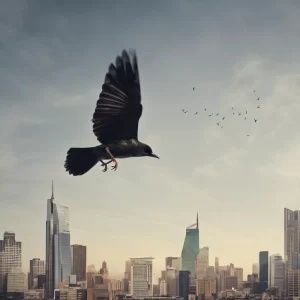Imagine a bustling cityscape filled with skyscrapers, honking cars, and throngs of people. Amidst this urban chaos, you may have noticed small feathered creatures flitting about: sparrows chirping on power lines, pigeons bobbing their heads on city streets, and crows cawing from the treetops. Have you ever wondered if these wild birds ever leave the city, seeking the solace of the countryside? Exploring the lives of city-dwelling birds unveils a fascinating world of adaptation, challenges, and surprising resilience. From the abundance of food sources to the impact of humans, from the seasonal movements to the role of urban parks, let’s uncover the secrets of these tenacious avian residents and ponder the future of birds in our concrete jungles.

Reasons birds live in cities
Food availability
One of the primary reasons why birds choose to live in cities is the abundant availability of food. Urban areas are often filled with various food sources that attract birds. City parks and gardens provide a wealth of vegetation and flowers, which produce seeds, berries, and nectar that birds can feast upon. Additionally, the presence of humans and their activities brings about a significant amount of food waste. Birds, such as sparrows, pigeons, crows, seagulls, and starlings, find plenty of opportunities to scavenge for scraps left behind by people.
Protection from predators
Cities offer a level of protection from natural predators that birds may encounter in rural or wilderness areas. Predators such as larger birds of prey or wild mammals may be less prevalent or absent altogether in urban environments. The presence of buildings, rooftops, and tall structures provides birds with safe perching spots to observe their surroundings and detect potential threats. This protection allows birds to focus on feeding, nesting, and raising their young without constant fear of predation.
Nesting opportunities
Another advantage of living in cities for birds is the abundance of nesting opportunities. Urban areas often contain an array of structures that can serve as potential nesting sites for various bird species. Tree cavities, building ledges, wall crevices, and even urban green spaces present suitable locations for birds to build their nests. This diversity of nesting options increases their chances of successfully reproducing and establishing populations in city settings.
Bird species in cities
Sparrows
Sparrows are one of the most common bird species found in urban areas. Their adaptability to different environments, including cities, makes them well-suited to urban living. Sparrows can thrive by primarily feeding on seeds found in urban vegetation and human food waste. Their ability to build nests in various structures, from tree hollows to small crevices in buildings, further contributes to their success in city environments.
Pigeons
Pigeons, often referred to as city pigeons or rock doves, are a familiar sight in urban areas around the world. These birds have adapted remarkably well to urban living and are known for their ability to navigate through cities. With a diverse diet that includes seeds, grains, and human food waste, pigeons find an abundance of food sources in cities. They often nest in nooks and crannies of buildings, bridges, and other urban structures.
Crows
Crows are highly intelligent birds that have adapted to urban habitats. They are known for their problem-solving abilities and resourcefulness. Cities provide crows with a plethora of food sources, including scraps, insects, and even small animals. Crows are also skilled nest builders and can take advantage of various urban structures to create their nests.
Seagulls
While seagulls are typically associated with coastal regions, they have also adapted to city life. The availability of food in urban areas, such as garbage dumps and fish markets, attracts seagulls to cities. Their ability to scavenge and their strong flying skills make seagulls well-suited to exploit the resources provided by urban environments.
Starlings
Starlings are highly social birds that often form large flocks in urban settings. They are known for their unique and acrobatic flight displays. Urban areas offer starlings ample food sources, including berries, seeds, and insects. These adaptable birds take advantage of nesting opportunities in cavities, from trees to building hollows.
Food sources for city birds
Urban vegetation
Urban areas often contain a rich diversity of vegetation, including trees, shrubs, and flower gardens. This vegetation produces seeds, berries, and nectar that serve as important food sources for city birds. Species like sparrows, starlings, and pigeons rely on urban vegetation to find nourishment and sustain their populations.
Human food waste
One of the notable benefits of living in cities for birds is the abundance of human food waste. Restaurants, markets, and residential areas generate significant amounts of discarded food, which becomes a readily available food source for birds. Species such as pigeons, crows, and seagulls have become experts at scavenging for these easily accessible food scraps.
Insects and invertebrates
Cities may have a higher concentration of insects and invertebrates compared to surrounding rural areas due to the presence of gardens, parks, and green spaces. Insects, such as flies, beetles, and spiders, provide a vital food source for birds. Many bird species, including sparrows and starlings, rely heavily on the abundance of these small creatures in urban environments.
Bird feeders
The presence of bird feeders in urban gardens, parks, and even balconies offers an additional source of food for city birds. Many people enjoy providing food for birds, and this supplementary feeding helps sustain bird populations in cities. Bird feeders are typically stocked with seeds, nuts, or suet, and attract a variety of bird species, including sparrows, starlings, and pigeons.

Challenges for city birds
Loss of natural habitat
The rapid urbanization and expansion of cities leads to the loss of natural habitats for bird species. As cities grow, forests, wetlands, and grasslands are often converted into concrete jungles. This loss of natural habitat poses a significant challenge for birds that rely on specific ecosystems for breeding, feeding, and resting.
Predation by domestic cats
Domestic cats are one of the primary threats to bird populations in cities. Cats are natural predators and their presence in urban areas, whether owned or feral, puts immense pressure on bird populations. Birds nesting at ground level, such as sparrows, are particularly vulnerable to predation by cats. Efforts to mitigate predation include responsible pet ownership, keeping cats indoors, and implementing trap-neuter-return programs for feral cat populations.
Collisions with buildings
The proliferation of tall buildings in cities poses a hazard for birds in the form of collisions. Large glass windows, reflective surfaces, and brightly lit buildings can confuse birds, causing them to crash into windows and facades. These collisions are often fatal or result in severe injuries. Designing buildings with bird-friendly features, such as fritted glass or external markings, can minimize the incidence of such collisions.
Air and noise pollution
Cities are notorious for their high levels of air and noise pollution, which can have adverse effects on bird populations. Air pollution, primarily from vehicle emissions and industrial activities, can impair respiratory function and weaken immune systems in birds. Noise pollution, such as constant traffic noise, can disrupt communication among birds, interfere with breeding behaviors, and deter them from occupying certain areas.
Benefits of city life for birds
Abundant food sources
One of the significant advantages that cities offer to birds is the abundance of food sources. As mentioned earlier, urban areas provide a wide range of nutritional options for birds, including urban vegetation, human food waste, insects, and bird feeders. This abundance of food helps birds thrive and successfully reproduce, leading to stable populations.
Reduced competition from other species
Compared to rural or wilderness habitats, cities may have fewer competing bird species due to the different environmental conditions. Birds specialized in urban living, such as sparrows and pigeons, may face less competition for resources, allowing them to flourish in city environments. This reduced competition can result in higher breeding success rates and overall population growth.
Climatic advantages
Cities often have what is known as the urban heat island effect, where temperatures in the city are slightly higher than in surrounding rural areas. This can create favorable climatic conditions for certain bird species that are more adapted to warmer climates. Warmer temperatures in cities can extend the breeding season and provide additional opportunities for nesting and raising young.
Artificial nesting sites
The presence of various urban structures, such as buildings, bridges, and even streetlights, provides birds with additional nesting opportunities. These artificial nesting sites can supplement the natural nesting sites that may not be readily available in urban areas. Birds take advantage of nooks and crannies in buildings or build nests on ledges to successfully rear their young.
Bird conservation in cities
Urban green spaces
Creating and maintaining urban green spaces, such as parks, gardens, and rooftop gardens, play a crucial role in bird conservation efforts in cities. These green spaces provide essential habitats for various bird species, offering food sources, nesting sites, and resting places. By preserving and expanding urban green spaces, cities can support diverse bird populations and contribute to overall biodiversity.
Bird-friendly urban planning
Urban planners can play a vital role in bird conservation by incorporating bird-friendly design principles into city projects. This includes incorporating vegetation, creating corridors for bird movement, and implementing measures to minimize the impact of buildings on bird populations, such as using bird-safe glass and reducing light pollution. By considering bird habitats in urban planning, cities can mitigate negative impacts on birds and create more sustainable environments for them.
Creating bird habitats
Cities can actively create bird habitats by installing nesting boxes, birdhouses, and platforms in suitable locations. These artificial structures can compensate for the loss of natural nesting sites and provide additional breeding opportunities for birds. By strategically placing these habitats in parks, gardens, and urban green spaces, cities can attract and support a diverse range of bird species.
Promoting citizen science
Engaging citizens in bird conservation efforts is crucial for creating awareness and gathering valuable data on bird populations in cities. Citizen science programs, such as bird counts and data collection on breeding behavior, can help scientists and conservationists assess the health of urban bird populations, identify trends, and guide conservation strategies. Encouraging citizen involvement through educational programs and community initiatives can make a significant difference in bird conservation efforts.
Impact of humans on city birds
Loss of habitat due to urbanization
Human activities, particularly urbanization, have resulted in the loss and fragmentation of natural habitats for birds. As cities expand, forests, wetlands, and grasslands are cleared or altered, displacing many bird species. The destruction of these habitats significantly impacts bird populations, limiting their access to essential resources for survival, reproduction, and migration.
Introduction of non-native species
Human activities, intentionally or unintentionally, have led to the introduction of non-native species in many urban areas. These non-native species can outcompete native bird species for resources, disrupt ecosystems, and pose threats to local biodiversity. Instances of non-native species, such as European starlings and house sparrows, aggressively displacing native birds have been observed in some cities.
Food provisioning and its consequences
While providing food for birds through bird feeders or intentional feeding may seem beneficial, it can have unintended consequences. Concentrated food sources can lead to overcrowding, competition, and the spread of diseases among bird populations. Supplemental feeding should be done with caution and following guidelines to minimize negative impacts on bird health and behavior.
Pollution and its effects
Human-generated pollution, such as air and noise pollution, can have detrimental effects on city birds. Air pollution, primarily from vehicle emissions and industrial activities, can lead to respiratory diseases, impaired reproductive success, and lower overall fitness in birds. Noise pollution can interfere with important communication and breeding behaviors, causing stress and disrupting bird populations.
Seasonal movements of city birds
Migration to breeding grounds
Many bird species that make cities their home during non-breeding seasons migrate to breeding grounds during specific times of the year. These seasonal movements can span hundreds or thousands of kilometers, as birds seek out suitable breeding habitats with abundant food and resources. Urban areas can act as temporary stopover sites for migrating birds, providing resting and refueling opportunities along their journey.
Migration to wintering areas
Similarly, some bird species that breed in northern latitudes migrate to southern regions during the winter months to escape harsh weather conditions and find more favorable feeding grounds. Urban areas in these wintering regions can serve as important winter habitats for birds, providing food sources and relatively milder climates compared to surrounding rural areas.
Long-distance migration from cities
Examples of wild bird species migrating from cities
Several wild bird species that live and breed in cities undertake long-distance migrations to reach their wintering or breeding grounds. For example, the European starling, commonly found in urban areas, migrates from northern Europe to southern Europe and North Africa during the winter. The American robin, another city-dwelling bird, migrates from its northern breeding range to southern regions of the United States and Mexico during the colder months.
Factors influencing long-distance migration
Long-distance migration from cities is influenced by various factors, including changes in daylight length, weather patterns, and the availability of food resources. Birds rely on their internal biological clocks, known as circannual rhythms, to time their migration accurately. Changes in resource availability trigger migratory behavior, as birds seek out areas with ample food and suitable conditions for breeding or overwintering.
Future of birds in cities
Effects of climate change on urban bird species
Climate change poses both opportunities and challenges for bird populations in cities. As temperatures rise, certain bird species that are adapted to warmer climates may expand their ranges further into cities. However, climate change also brings about increased weather extremes and shifts in the availability of resources, which can negatively impact bird populations. Adapting urban environments to mitigate the effects of climate change becomes crucial for the future survival of birds in cities.
Urban planning for bird conservation
Urban planning will play a vital role in ensuring the future of birds in cities. By incorporating bird-friendly design principles, preserving or creating green spaces, and considering the needs of bird populations, cities can provide habitats and resources necessary for birds to thrive. Collaborations between urban planners, conservationists, and community stakeholders can drive sustainable development that benefits both humans and birds.
Community involvement in bird conservation efforts
Ultimately, the future of birds in cities rests in the hands of communities. Engaging and educating residents about the importance of bird conservation, the impacts of human activities, and ways to mitigate negative effects are crucial for creating a sustainable and bird-friendly urban environment. Through community involvement, local initiatives, and supporting conservation organizations, individuals can make a positive difference in ensuring the well-being and survival of birds in cities.

My name is Shane Warren, the author behind Your Bird Buddy – your ultimate guide to the wonderful world of birds! Unleash your inner avian explorer as we delve into a vibrant library of knowledge dedicated to all things feathered. From learning about diverse bird species from across the globe to understanding their captivating habitats and behaviors, I’m here to fuel your passion for these magnificent creatures. Not only that, but I also provide valuable insights on being a responsible and informed pet bird owner. Join our vibrant community and let’s celebrate the feathered wonders of the world together – one chirp at a time. And be sure to join our Your Bird Buddy Community over on Facebook!


Comments are closed